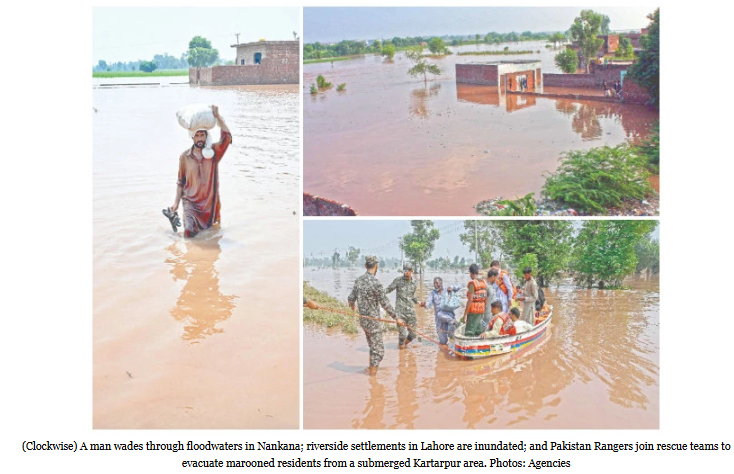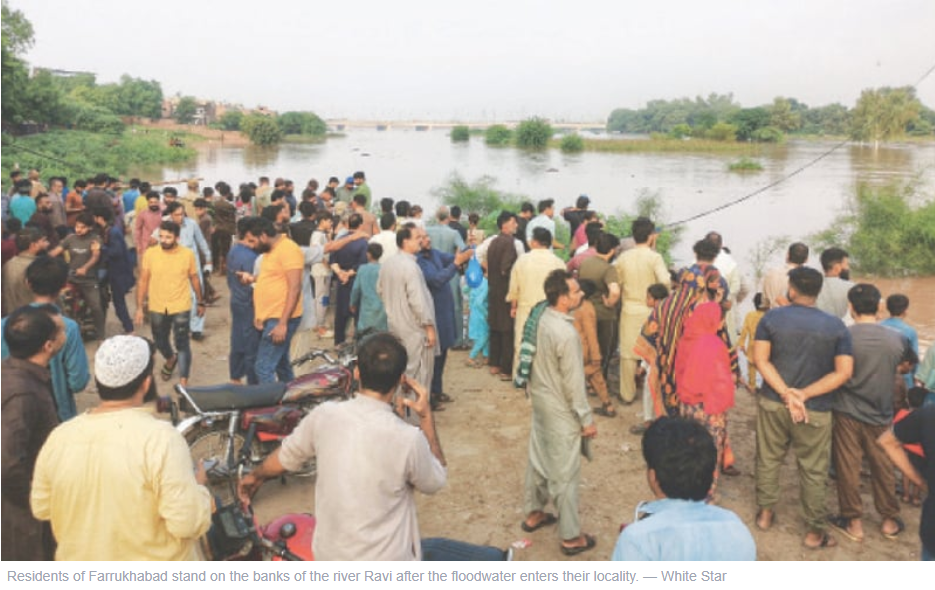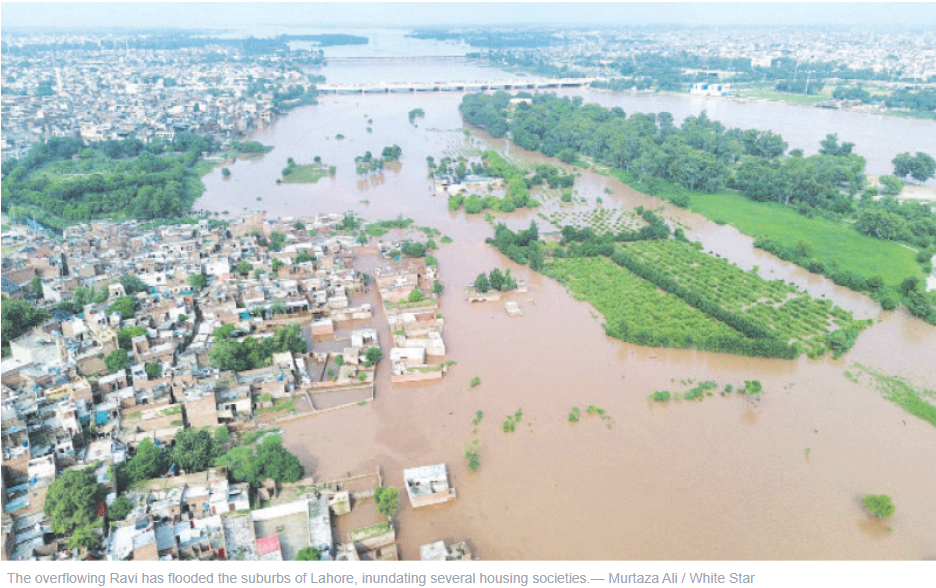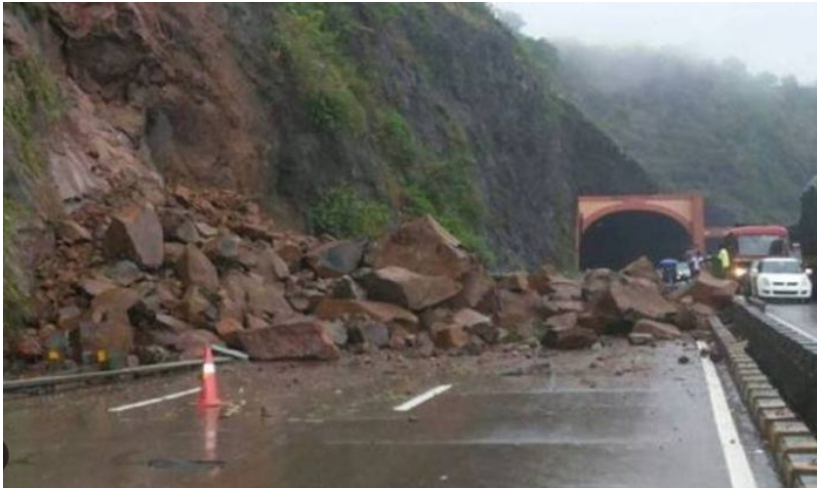标题:Lahore holds off Ravi surge
时间:2025-8-29
正文:

LAHORE:
Authorities were locked in a fierce battle on Thursday to save Lahore from the surging Ravi, as floodwaters swelled to dangerous levels at Shahdara and Balloki headworks, threatening the city's outskirts and nearby villages.
With more than a million people displaced and at least 22 people killed across the province, the situation has grown into one of the worst flood emergencies in recent years and posed a grave test for the administration and all its institutions.
As authorities struggled in wake of catastrophic floods, the National Disaster Management Authority (NDMA) warned that continued rainfall could aggravate flood conditions along rivers Ravi, Sutlej, and Chenab in the next 48 hours.
"People should immediately contact local authorities and rescue officials in case of emergency," the NDMA said, adding relief operations were ongoing and were being closely monitored. "All institutions are ensuring preparedness to deal with any crisis."
In Lahore, a round-the-clock monitoring of vulnerable points of the Ravi continued as flows touched 219,770 cusecs at Shahdara, while Balloki recorded 117,490 cusecs and rising — volumes that forced the administration to declare "critical vigilance."
The scale of devastation elsewhere underscored the challenge. According to Rescue 1122 officials, 22 people have lost their lives in flood-related incidents during the past few days.
Authorities reported that 263 relief camps had been established, with 365 rescue missions carried out to date. Helicopters and boats were mobilised for the most inaccessible areas.
The fatalities were spread across multiple districts. In Gujrat, three children drowned after an embankment collapsed. In Sialkot, five members of a single family perished when their house was swept away.
Further casualties were reported from Gujranwala, Hafizabad, and Narowal as swollen rivers and nullahs broke through protective dykes. Officials warned that the death toll could climb as rescue teams gained access to cut-off villages.
Among Punjab's rivers, the Chenab carried the heaviest burden. At Qadirabad headworks, inflows peaked at an extraordinary 996,000 cusecs — well above the barrage's design capacity of 800,000 cusecs.
To prevent total collapse, authorities deliberately breached protective bunds near Mandi Bahauddin and Ali Pur Chatha, diverting floodwaters into agricultural tracts to relieve pressure on the structure.
At Khanki, inflows touched 859,000 cusecs, inundating dozens of villages along the banks. Thousands of acres of standing crops were submerged, leaving farmers devastated just weeks before harvest.
Residents described desperate escapes as they abandoned livestock and belongings to the water. Trimmu, further downstream, recorded nearly 99,000 cusecs and remained steady, though officials said any new surge could overwhelm low-lying embankments.
The Sutlej, swollen by continuous rains and heavy flows from across the border, added to the province's woes. At Sulemanki headworks, flows rose to 113,124 cusecs, while at Islam headworks the river carried 54,756 cusecs.
Temporary dykes in Kasur, Pakpattan, and Bahawalnagar collapsed under the pressure, flooding farmland and forcing hundreds of families to evacuate overnight, local villagers said.
They reported using tractor trolleys and makeshift rafts to move the elderly, children, and livestock to higher ground. Many complained of inadequate relief, saying that the speed of rising water had left them with little more than the clothes they wore.
In Multan, officials warned that floodwater was approaching the city as massive inflows move downstream. To divert the Chenab's pressure, breaches were made at protective dikes near Head Muhammadwala, with officials confirming that 60% of residents in threatened areas have been evacuated.
In Narang Mandi, dozens of villages have been cut off, while in Sheikhupura's Sharaqpur Sharif, river water has reached levels not seen since 1988. In Wazirabad, Nullah Palkhu overflowed, inundating villages and low-lying neighbourhoods.
Sialkot International Airport was temporarily closed after floodwaters reached its premises. Pakistan International Airlines announced that flights were being rerouted to Lahore.
Residents of Arifwala tehsil said floodwaters entered homes after the Ravi and Sutlej converged, pushing inflows close to 100,000 cusecs. Officials said more than 600,000 people have been affected across Punjab, with hundreds of villages under water.
The Ravi remained the focus of urgent concern. At Jassar, it carried 99,470 cusecs, while flows at the Ravi Siphon touched 220,627 cusecs. Downstream at Shahdara, it reached 219,770 cusecs and continued steady, threatening northern edges of Lahore.
Authorities said embankments had been reinforced with stone pitching, while machinery was positioned to plug breaches if they occurred.
Officials also reported that Sidhnai headworks, further south, recorded 25,743 cusecs and rising. Though less severe than upstream levels, the rise posed risks for districts already weakened by earlier rains.
Narowal faced severe devastation as farmland and settlements were submerged by torrents from the Ravi and associated nullahs. The Shakargarh-Narowal road was rendered impassable, cutting off access to several tehsils.
Floodwater reached railway tracks near Qila Ahmadabad, suspending train services on the Narowal-Sialkot route. Local accounts described scenes of panic as villages were evacuated in haste, with many residents wading chest-deep through water carrying bundles of food or leading buffaloes to safety.
Officials cautioned that the danger was far from over. The Meteorological Department forecast heavy rains and thunderstorms across the country, including central and northern Punjab over the next 48 hours.
The NDMA issued an alert after the Met Department's forecast of widespread rain and thunderstorms across the country from August 29 to September 2, warning of possible flooding and landslides in several regions.
According to NDMA, northern and north-eastern districts of Punjab, including Rawalpindi, Attock, Jhelum, Chakwal, Lahore, Gujranwala, Sialkot, Gujrat, Narowal, Hafizabad, and Mandi Bahauddin, are likely to witness heavy rains on August 30 and 31, raising concerns of flooding.
Central and southern Punjab are also expected to receive downpours from August 29 to 31, with low-lying areas at risk of inundation. Districts including Multan, Dera Ghazi Khan, Rajanpur, Layyah, Bhakkar, Sahiwal, Bahawalpur, Bahawalnagar, and Rahim Yar Khan may experience flood-like conditions.
In Khyber-Pakhtunkhwa, heavy rains are expected from August 29 to 31. Malakand and Hazara divisions are particularly vulnerable to landslides, with districts such as Chitral, Dir, Swat, Buner, Mansehra, Abbottabad, Peshawar, Nowshera, Mardan, Dera Ismail Khan, Tank, Kohat, and Bannu on alert.
Azad Jammu and Kashmir (AJK)area, including Muzaffarabad, Bagh, Haveli, Kotli, Mirpur, and Bhimber, may face intense rains between August 29 and September 2, with landslides a potential threat.
In Gilgit-Baltistan, heavy rains are forecast from August 29 to 31, with authorities warning of landslides and the risk of glacial lake outburst floods (GLOF) in districts including Gilgit, Skardu, Hunza, Diamer, Astore, Ghizer, and Ghanche.
Sindh's coastal districts, including Karachi, Thatta, Sujawal, Badin, and Tharparkar, are expected to receive heavy rainfall between August 30 and September 2. The NDMA cautioned that Karachi faces the risk of urban flooding due to potential downpours.
Other Sindh districts including Hyderabad, Dadu, Sukkur, Ghotki, Larkana, Jacobabad, and Kashmore could also witness torrential rains between August 30 and September 1.
In Balochistan, coastal and eastern districts such as Gwadar, Kech, Panjgur, Khuzdar, Lasbela, and Kalat are likely to be hit by rains from August 29 to September 1, with the possibility of flooding in low-lying areas.
Rescue teams have been placed on high alert in Lahore, Gujranwala, Faisalabad, Sialkot, and southern Punjab districts. Authorities urged residents of low-lying areas to heed evacuation orders immediately. "Lives are more important than property," one official said, appealing to villagers reluctant to abandon livestock.
Despite extensive mobilisation, the sheer scale of the flooding has stretched resources. With 263 camps already functional, district administrations are struggling to provide adequate shelter, food, and medical assistance to displaced families.
In Narowal alone, hundreds sought refuge in schools and mosques converted into temporary shelters. In Sialkot, residents complained of shortages of drinking water and medicines.
Helicopter sorties dropped food packets in areas inaccessible by road. Boats ferried people across flooded expanses in Hafizabad and Gujranwala, while makeshift rafts were seen on village tracks.
Relief Commissioner Nabeel Javed admitted the challenge was "monumental," but said coordinated efforts by civil administration, Rescue 1122, and the army were keeping casualties lower than feared.
Long road ahead
Even as water levels fell marginally at Marala, Khanki, and Qadirabad headworks on Thursday evening, experts warned the reprieve could be temporary. With monsoon still active and inflows across the border continuing, rivers could rise again.
Farmers in affected areas said rehabilitation would take months, if not years, with homes destroyed, livestock lost, and fields buried under silt. Officials say the extent of the damage would be known only after water receded.
For Lahore, the battle at Shahdara and Balloki remained decisive. Authorities insisted embankments would hold, but contingency plans were in place should the Ravi push further into the city.
Officials said flooding in the Chenab, Sutlej, and Ravi rivers has devastated nearly 1,400 villages, displacing more than 1.2 million people. The next 48 hours, they added, would be crucial in determining whether Punjab's largest city escapes disaster.
来源:the tribune
url:
https://tribune.com.pk/story/2563866/lahore-holds-off-ravi-surge
标题:Five Lahore localities flooded by the Ravi
时间:2025-8-29 09:04:00
正文:

LAHORE: The floodwater in the River finally entered Lahore’s five residential localities on Thursday morning, inundating roads and damaging houses and other infrastructure. However, the timely evacuation saved the residents, as none of them was found stranded in the floodwater, it is learnt.
The localities suffered due to flood included Shafiqabad, Farrakhabad and Tallat Park near Shahdara bridge and Theme Park, near Chuhng (Multan Road) and Park View.
“At the moment, the Ravi is full of floodwater having flows of nearly 220,000 cusecs whereas the designed capacity of the river is 250,000 cusecs,” revealed Lahore Deputy Commissioner Syed Musa Raza while talking to Dawn on Thursday.
According to him, Lahore witnessed worst-ever floods in 1988 after Ravi received 345,000 cusecs flows - around 100,000 cusecs more than the designed capacity - and caused massive destruction in Shahdara and adjoining localities.
“After the 1988 floods, the water flows measuring 220,000 in the Ravi at the moment is so far the highest one,” he said, expecting reduction in the flows in coming days if no discharge of water from India up to downstream is done.
Human loss averted due to timely evacuation
Talking about the residents’ evacuation from the aforementioned localities, he said at present none of the families are present there as all have been evacuated on time. Some voluntarily left the area and temporarily shifted to their relatives in various parts of the city.
“Some preferred to shift to the relief camps set up by the administration in various schools. Meal is being served to them three times. Mattresses, pillows etc have also been provided to the affected people present in the camps,” he said, adding that most families have shifted their household goods to the first floor of their houses in a bid to save them from floodwater.
DC Mr Raza said the animals owned by the residents have also been shifted to safe places.
To a question, he said there is no danger to Park View Housing Society, as the developers have built a major embankment to save its one block situated near the river. “The developers have carried out round-the-clock work and built a huge embankment there. Now there is no danger at all. Moreover, evacuation of the residents has already been done,” he said, adding that Rescue 1122 and other relief services have been made available to deal with any flood-related emergency.
People face problems in shifting their household items. — White Star
On the other hand, some residents of Park View scheme claimed that water flowed into two tail-end uninhabited blocks on Wednesday night.
In a late night (Thursday) development, the water entered some more blocks. However, the people left and locked their houses to shift to their relatives or the relief camps. “The floodwater has left us with no option but to leave this area,” said a resident while talking to Dawn on phone.
The district administration also stationed various officials at the society to monitor and deal with the flood situation in association with various departments concerned.
In Theme Park, the people panicked following announcements from the government to leave the area prior to arrival of the floodwater. “The floodwater entered several houses, including ours. Thanks God, all remained safe as we left the area well on time,” said Jannat Bibi, a resident of Theme Park. “At present we are living in a house at Samsani village, Johar town owned by our relative,” she added.
来源:DAWN
url:
https://www.dawn.com/news/1938079/five-lahore-localities-flooded-by-the-ravi
标题:1.5m affected as Punjab reels from ‘worst flood in decades’
时间:2025-8-29 07:43:00
正文:

• PM Shehbaz, CM Maryam oversee massive relief and evacuation operation
• Over 1,400 villages inundated; grain crops submerged
• Chenab expected to swell to dangerous level at Head Trimmu
• Sialkot airport shut due to floodwater
• Minister says no compensation for structures built illegally in high-risk areas
MANDI BAHAUDDIN: Residents wade through a flooded road in Qadirabad village near the River Chenab.—Reuters
LAHORE: The Punjab government has launched one of its largest evacuation operations in recent years, as floodwaters affected over 1.46 million people across the province, with the Chenab River expected to swell to dangerous levels at Head Trimmu.
Extremely high floods in the Sutlej, Ravi and Chenab rivers have also resulted in the loss of 17 lives.
The province is battling its worst flooding in four decades, which has caused havoc in hundreds of villages and submerged vital grain crops.
Torrential monsoon rain and India’s release of excess water from its dams swelled the three rivers that flow into the province, forcing authorities to breach riverbanks in some places and causing flooding in more than 1,400 villages.
Authorities warned that between 700,000 and 800,000 cusecs of water could pass through the Chenab River system in the next 48 hours, threatening widespread devastation.
The relocation effort covers several districts and hundreds of towns, including Jhang, Shorkot, Khanewal, Multan, Muzaffargarh, Shujaabad, Jalalpur Pirwala and Alipur.
Water levels
As of 12am on Friday, Trimmu near Jhang was in normal flow at 117,534 cubic feet per second (cusecs), but was showing a rising trend, according to the Flood Forecasting Division.
The division reported falling trends upstream. At Marala Headworks near Sialkot, the flow has dropped to 106,496 cusecs (low flood), while both Khanki and Qadirabad headworks stand at 305,436 cusecs.
While the Ravi River has stabilised at Jassar near Narowal (95,580 cusecs), Shahdara was in “exceptionally high flood” with a water outflow of 219,770 cusecs, though the trend was steady. The next stop, Head Balloki near Pattoki, was in the “high flood” category at 114,110 cusecs and showing a rising trend.
Further downstream, Head Sidhnai near Abdul Hakeem showed a rising trend, with an inflow of 25,443 cusecs and outflow of 10,093 cusecs.
On the Sutlej River, Ganda Singh Wala near Kasur was in “exceptionally high flood” at 261,053 cusecs, Sulemanki near Bahawalnagar was in “medium flood” at 113,124 cusecs, and Head Islam was in “low flood” at 52,706 cusecs.
Meanwhile on the Indus River, Tarbela Dam showed a normal flow with an outflow of 155,400 cusecs.
Scale of damage
According to PDMA data, over 1.46 million people in 1,692 mouzas have been affected due to extremely high floods in the Sutlej, Ravi and Chenab rivers, with a total of 17 lives lost.
The government has evacuated over 265,000 people, of whom 1,372 were living in 355 relief camps and 6,656 were provided with medical help, whereas 90,348 people and 154,980 cattle were transported to safety.
A total of 991 villages were submerged due to flooding in the Chenab River. Some 395 villages were affected by the floods in Sialkot, 127 in Jhang, 124 in Multan, 48 in Chiniot, 66 in Gujrat, 51 in Khanewal, 45 in Hafizabad, 41 in Sargodha, 35 in Mandi Bahauddin, and 19 villages in Wazirabad.
Due to flooding in the Chenab, more than one million people have been evacuated and relocated to safe locations so far. Some 73,000 animals have been moved to safe locations, and 72 veterinary camps have been set up in affected districts.
In the Ravi, around 80 villages were submerged, including 75 in Narowal, four in Sheikhupura, and one in Nankana Sahib. Around 11,000 people have been evacuated and relocated to safe locations so far. Nearly 4,500 animals have been moved to safe locations. A total of 52 veterinary camps have been set up in affected districts.
As for the Sutlej River, a total of 361 villages were submerged, including 72 in Kasur, 86 in Okara, 24 in Pakpattan, 27 in Multan, 23 in Vehari, 104 in Bahawalnagar and 25 villages in Bahawalpur. Nearly 127,000 people have been evacuated and relocated to safe locations so far. A total of 70,000 animals have been moved to safe locations, whereas 90 veterinary camps have been set up.
‘No compensation’
Information Minister Attaullah Tarar on Thursday lauded the exemplary coordination among all stakeholders for averting a major flood disaster in Gujranwala and Wazirabad.
Speaking to the media in Wazirabad, he assured that arrangements were in place for the provision of relief items, including tents, food and medical supplies.
A survey is currently underway to estimate livestock losses, and compensation will be provided to affected individuals. However, he stressed that no compensation would be given for structures built illegally in these high-risk areas.
Meanwhile, flooding also disrupted flight operations at Sialkot International Airport, where services were suspended for 24 hours on Thursday.
![ .]https://www.dawn.com/news/1937816/the-million-cusec-problem)
The airport spokesperson confirmed that the runway and terminal were safe, with drainage work underway.
An official told Dawn that the last flight from Sialkot airport — a Dubai-bound Flydubai — departed on Thursday morning.
PM, CM visit affected areas
Prime Minister Shehbaz Sharif, accompanied by Punjab Chief Minister Maryam Nawaz Sharif, conducted an aerial survey of affected areas on Thursday. NDMA Chairman Lt Gen Inam Haider briefed the premier on the overall situation.
During her visit to the Ravi, CM Maryam expressed regret that the crisis had been aggravated by the opening of spillways by India but noted that the province’s early warning system was functioning effectively, allowing the timely evacuation of residents.
International support
President Recep Tayyip Erdogan of Turkiye phoned PM Shehbaz to express solidarity and offer assistance in rescue and relief efforts.
“Turkiye stands ready to help in any way possible, including during the rescue and relief efforts,” President Erdogan said, according to the PM Office.
PM Shehbaz thanked him for the support, calling it reflective of the “deep-rooted fraternal ties” between the two nations.
Zulqernain Tahir in Lahore, Waseem Ashraf Butt in Gujrat and Syed Irfan Raza in Islamabad also contributed to this report. With input from APP and Reuters
来源:DAWN
url:
https://www.dawn.com/news/1938038/15m-affected-as-punjab-reels-from-worst-flood-in-decades
标题:Traffic on Swat Expressway affected due to landslide
时间:2025-8-29
正文:

ISLAMABAD, Aug 29 (APP): Due to landslide at Chakdara again, the flow of traffic was effected on Swat Expressway.
In a statement issued here on Friday, traffic going to Peshawar and Islamabad has been diverted from Chakdara Toll Plaza to GT Road, following the condition.
While traffic heading to Swat was redirected towards GT Road through the Palie Interchange.
Motorway Police and FWO teams were working together to restored the traffic flow on this route.
来源:app.com
url:
https://www.app.com.pk/national/traffic-on-swat-expressway-affected-due-to-landslide/